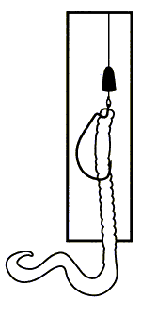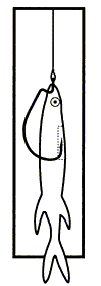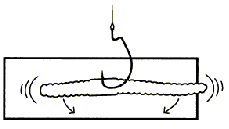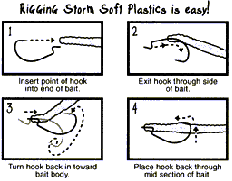| Rigging Storm Soft Plastic Baits
/ Texas Rig / Carolina
Rig / Finesse Rig / Wacky
Rig / Drop Shot Rig / Split
Shot Rig / Storm Craw Rig / Storm
Grub Rig |
| Rigging Storm Soft
Plastic Baits |
|
| The introduction of soft plastic baits to the
Storm product range in 2002 opened up new opportunities to many
thousands of enthusiastic lure fishermen. In addition, the use
of soft plastic baits is becoming increasingly popular around
the world.
There is no doubt that the vast majority of predatory fish
are quite happy to take a soft plastic bait, and there are
some species that demand the use of soft plastics in preference
to hard baits.
Many fishermen are keen to try new fishing techniques, however,
their lack of knowledge often prevents them from doing so.
If they are not sure that they are using the right technique
they have no confidence in their fishing and will revert to
methods that they know well.
Storm lures help the fisherman by including rigging instructions
with their soft baits. There are of course many ways to rig
soft baits, and initially Storm Lures have concentrated upon
the most popular rigging patterns.
The purpose of this newsletter is to impart the rigging information
to all our journalist and pro fishermen friends around the
world, in order that you can help fishermen to benefit from
the significant advances in soft
plastic bait design made available by Storm Lures.
STORM JIG HEADS
In addition to their range of soft plastic baits, Storm also
manufactures a range of Jig Heads.
There are various models available in a variety of colours
and sizes to suit different designs of soft plastic baits.
The Storm Jig Heads are all available in a comprehensive
range of weights to suit all fishing conditions.
|
|
|
One of the favourite "Weedless" rigs of American
anglers, for use in a variety of vegetation; the Texas Rig can
be used with the following Storm lures:
All of these lures are unweighted; therefore a "worm
weight" is included in the rigging kit.
- Slide the "worm weight" onto the line, and attach
the line to the hook.
- Insert the point of the hook into the front of the head
of the bait.
- Bring the hook point out of the side of the bait no more
than 5 mm behind the head.
- Feed the bait onto the hook up to the eye.
- Insert the hook into the same side of the bait, about
4 cm behind the head, and feed the bait around the hook
until the hook is positioned just under the skin of the
lure on the top side.
|
 |
|
|
Another popular American rig, the Carolina is versatile in
that the fisherman can adjust the size of the weight and the
length of the leader, to suit the fishing conditions.
The Carolina Rig can be used with the following Storm lures:
- Ribbon Tail Worm
- Rattle Hot Craw
- Insert the point of the hook into the front of the head
of the bait.
- Bring the hook point out of the bottom of the bait no
more than 5 mm behind the head.
- Feed the bait on to the hook up to the eye.
- Insert the hook into the bottom of the bait, about 4 cm
behind the head, and push the hook up and forward into the
bait so that the point lays flat along the top of the bait,
then lightly secure the point of the hook just under the
skin of the lure.
- Tie between 45 and 60 cm of line to the hook.
- Slide a suitable egg weight and a bead on to the main
line, and tie a swivel to the end.
- Attach the bait to the main line by tying the bait line
to the swivel.
|
 |
| Finesse Rig (or
Weightless Rig) |
|
This rig lives up to its name. It is designed for very light,
delicate fishing. No weights are involved with this rig.
The Finesse Rig can be used with the following Storm lures:
- Rattle WildEye Split Tail Minnow
- Insert the point of the hook into the front of the head
of the bait.
- Bring the hook point out of the side of the bait no more
than 5 mm behind the head.
- Feed the bait onto the hook up to the eye.
- Insert the hook into the same side of the bait, about
4 cm behind the head, and feed the bait around the hook
until the hook is positioned just under the skin of the
lure on the top side.
|
 |
|
|
|
A simple rig designed to produce the maximum action when
worm baits are jigged quickly, this rig is used to make the
lure fall slowly with an unnatural, head first sinking worm
action.
The Wacky Rig can be used with the following Storm lures:
- Tie the hook direct to the main line.
- Simply insert the hook almost half way along the bait.
- Turn the hook so that it only penetrates half way through
the bait.
- Bring the point of the hook out of the bait on the same
side as it entered.
|
 |
|
|
|
The Drop Shot Rig is useful if you need to control just how
far your bait is off the bottom. The idea is to suspend the
bait above the bottom by using a pre-determined length of
line below the bait, attached to a drop shot weight.
The Drop Shot Rig can be used with the following Storm lures:
- Insert the point of the hook into the front of the head
of the bait.
- Bring the hook point out of the side of the bait no more
than 5 mm behind the head.
- Feed the bait onto the hook up to the eye.
- Insert the hook into the same side of the bait, about
4 cm behind the head, and feed the bait around the hook
until the hook is positioned just above the skin of the
lure on the top side.
- Select a piece of suitable line of the length you require
(between 30 and 60 cm). Tie one end to a suitable drop shot.
- Thread the other end of the line through the hook eye,
and tie a small loop.
- Attach your main line to the loop.
|
 |
|
|
|
A rig that is infinitely adjustable through the length of
line between the split shot and the bait, and the size of
the split shot itself.
The Split Shot Rig can be used with the following Storm lures:
- Rattle Craw Worm
- Finesse Minnow
- Insert the point of the hook into the front of the head
of the bait.
- Bring the hook point out of the side of the bait no more
than 5 mm behind the head.
- Feed the bait onto the hook up to the eye.
- Insert the hook into the same side of the bait, about
4 cm behind the head, and feed the bait around the hook
until the hook is positioned just above the skin of the
lure on the top side.
- Tie a length of suitable line between 30 and 60 cm long
to the hook.
- Slide a bead on to the main line and attach a swivel to
the end.
- Squeeze a split shot of the correct size immediately above
the bead.
- Tie the line from the hook to the swivel.
|
 |
|
|
|
A rig designed specially for the Storm
Rattle Hot Craw Tube.
Using a Barbarian Football Jig Head feed the point of the
hook into the tail of the bait. There is a channel inside
the bait to make this an easy operation.
- Feed the bait along the shank of the hook.
- The hook exits the top of the bait just behind the head.
- Secure the tail of the bait on the bait holder hook of
the jig head.
|
 |
|
|
A rig specially designed for the Storm
Rattle Grub.
- Select either a Storm Hammerhead or Football Jig Head.
- Insert the point of the hook into the front of the head
(Rattle Grub) or into e front of the head of the bait at
the skirt end (Twin Tail Grub).
- Work the bait along the hook until the body is over the
bait holder hook on the jig head.
- The hook should exit the side of the bait just in front
of the rattle chamber (Rattle Grub) or just in front of
the tail (Twin Tail Grub).
|
 |